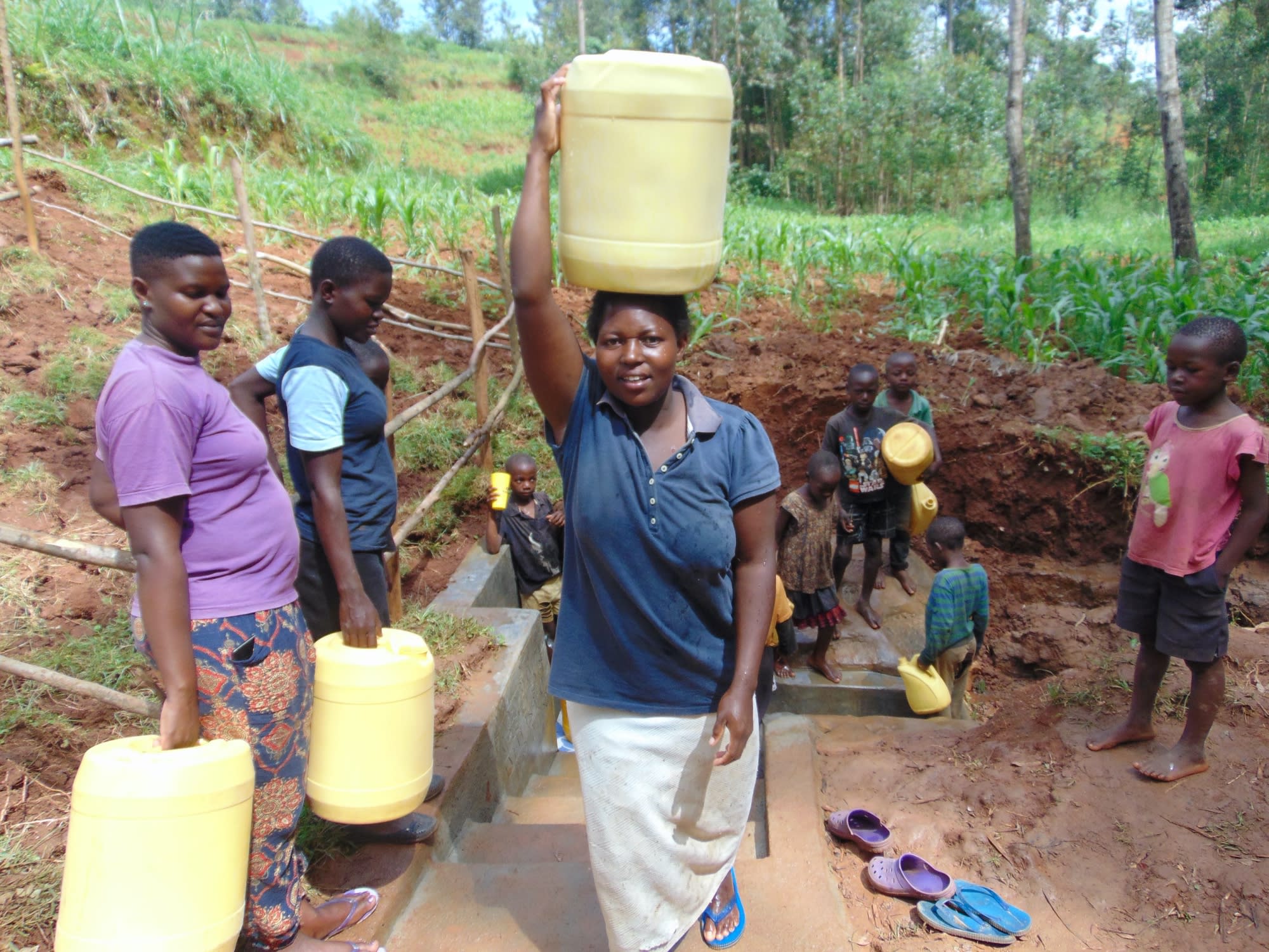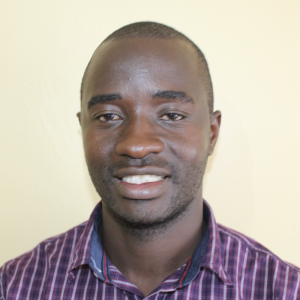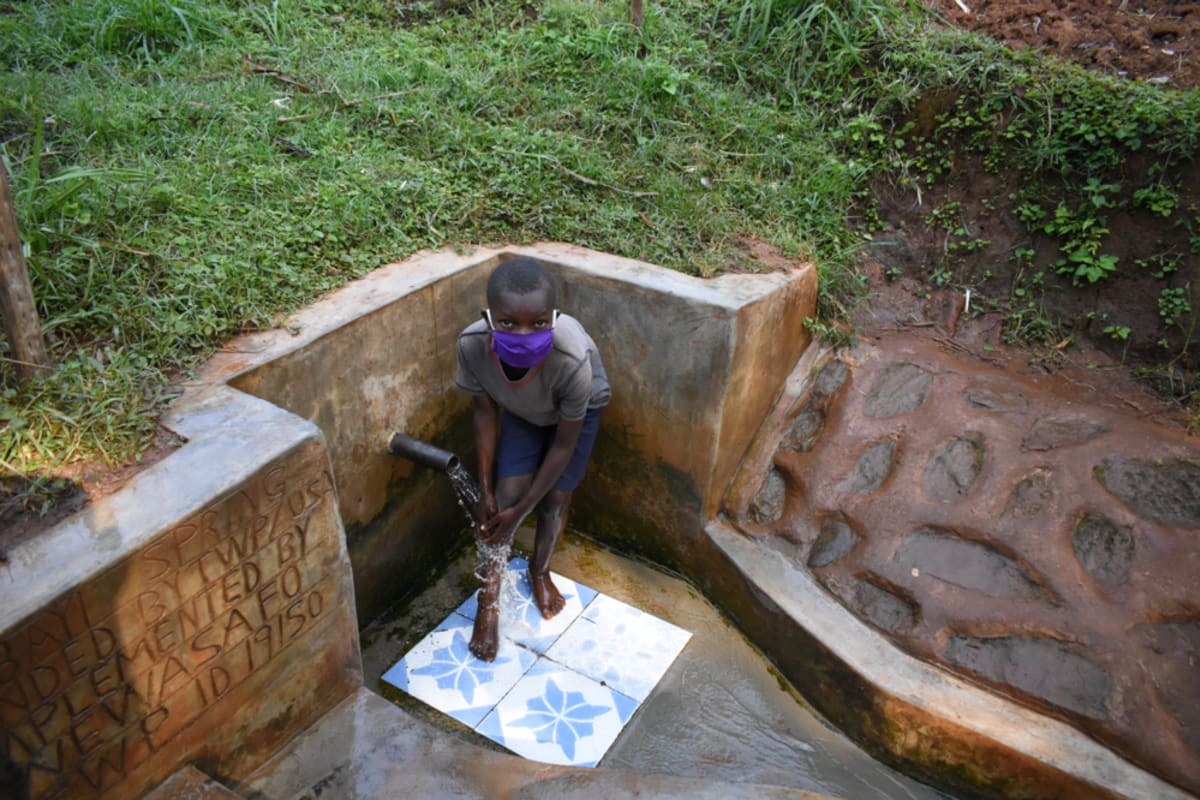May, 2020: COVID-19 Prevention Training Update at Butiti Community, Imbayi Spring
Our teams are working on the frontlines of the COVID-19 pandemic. Join us in our fight against the virus while maintaining access to clean, reliable water.

We are carrying out awareness and prevention trainings on the virus in every community we serve. Very often, our teams are the first (and only) to bring news and information of the virus to rural communities like Butiti, Kenya.
We trained more than 28 people on the symptoms, transmission routes, and prevention of COVID-19. Before there were any reported cases in the area, we worked with trusted community leaders and the Water User Committee to gather community members for the training.

We covered essential hygiene lessons:
- Demonstrations on how to build a simple handwashing station
- Proper handwashing technique
- The importance of using soap and clean water for handwashing
- Cleaning and disinfecting commonly touched surfaces including at the water point.

We covered COVID-19-specific guidance in line with national and international standards:
- Information on the symptoms and transmission routes of COVID-19
- What social distancing is and how to practice it
- How to cough into an elbow
- Alternative ways to greet people without handshakes, fist bumps, etc.
- How to make and properly wear a facemask.

During training, we installed a new handwashing station with soap near the community’s water point, along with a sign with reminders of what we covered.
Due to the rampant spread of misinformation about COVID-19, we also dedicated time to a question and answer session to help debunk rumors about the disease and provide extra information where needed.
We continue to stay in touch with this community as the pandemic progresses. We want to ensure their water point remains functional and their community stays informed about the virus.
Water access, sanitation, and hygiene are at the crux of disease prevention. You can directly support our work on the frontlines of COVID-19 prevention in all of the communities we serve while maintaining their access to safe, clean, and reliable water.

November, 2019: Shamakhokho Community, Imbai Spring Project Complete!
Shamakhokho Community (previously mislabeled as Butiti) now has access to clean water! Imbai Spring has been transformed into a flowing source of water thanks to your donation. We protected the spring, provided 5 sanitation platforms to different households in the community, and we trained the community on improved sanitation and hygiene practices.

Village Elder Damaris (in center with hands up) celebrates the new spring with her community
Spring Protection - "Whistle for Water"
As the saying goes, unity is strength, and so it was at Imbai Spring. The 3 village elders representing the 3 villages served by Imabi Spring across Shamakhokho (Mukhunya B, Bumavi, and Bumira) came together in mobilizing the community for spring construction. They engaged the best mobilization method of whistling as everyone in this village respects the whistle of the village elders. Whenever it is heard, all the community members come out in large numbers to hear what their local leaders have to say as they really believe in them.

Village elder whistles for her community to start mobilizing construction materials
The whistle worked for us very well. Each day as the village elder whistled, the women and men came running to the spring, each carrying either a stone, a brick, or availing themselves for helping out the artisans at the spring. What magic that the whistle ensured safe drinking water flowing from the spring. Networking and collaboration with all stakeholders on the ground was a key lesson learned for the success of any project.

Delivering materials to the construction site
The Process
Community members provided all locally available construction materials, including bricks, wheelbarrows of clean sand, stones, and fencing poles. Accommodations and meals were provided for the artisan, too.
Women and men lent their strength to the artisan to help him with manual labor. The spring area was excavated to create space for setting the foundation of thick plastic tarp, wire mesh, and concrete. The community members came out in full to help the skilled artisan with this part of the construction, which is normally the heaviest part of the work. After the base had been set, both wing walls and the headwall were set in place using brickwork. The discharge pipe was fixed low in place through the headwall to direct the water from the reservoir to the drawing area.

Building the spring walls brick by brick
As the wing walls and headwall were curing, the stairs were set and ceramic tiles were fixed directly below the discharge pipe. This protects the concrete from the erosive force of the falling water and beautifies the spring. The process of plastering the headwall and wing walls on both sides reinforces the brickwork and prevents water from the reservoir from seeping through the walls and allows pressure to build in the collection box to push water up through the discharge pipe.

Looking at the spring from behind the headwall, yet to be backfilled
The source area was filled up with clean stones and sand and covered with a thick plastic tarp to prevent potential sources of contamination. With all preparations done on time and the weather being favorable, there were no delays through the entire spring construction process. It took about 2 weeks of patience for the concrete to dry.

Newly constructed Imbai Spring, complete with fencing and planted grass
As soon as it was ready, people got the okay from our field officers to begin fetching clean water. We met them there to celebrate this momentous occasion.
"Protection of Imbai Spring will improve the living standard of the people of Shamakhokho since they will no longer spend much time and resources in treating diseases caused by taking contaminated water," said Bumavi Village Elder Damaris Khalechi.

Bumavi Village Elder Damaris Khalechi
"The women in this community looked more enthusiastic about the new water point since they are the ones who are always on the receiving end. This happens mostly when the children fall sick and when they have to fetch water from the unprotected spring. With the African culture, men don't get so much involved in house chores which are termed as work for women. Having water flowing from the pipe has reduced time used to fetch water from the spring."

Sanitation Platforms
All 5 sanitation platforms have been installed. These 5 families are happy about this milestone of having a private latrine of their own and are optimistic that people will no longer leave waste outdoors. We are continuing to encourage families to finish building walls and roofs over their new latrine floors.

Proud new sanitation platform owner
New Knowledge
Samuel Imbai, the spring's landowner and elected Chair of the water, sanitation, and hygiene committee, was tasked with organizing the training. This community had already elected their entire water committee leadership before construction began, which greatly helped in spreading the word about mobilizing the materials during construction and sending out the invitation for training.
This spring is also unique in that it serves community members from 3 different villages (Mukhunya B, Bumavi, and Bumira) thus the 3 village elders joined hands in mobilizing their communities for the spring construction and training. This combined group gave us the community’s preferred date for training, for they were very much aware of the community calendar when it comes to planting season and other big events.
When the training day arrived, however, we were surprised to see just 10 women prepared to learn. As it turns out, many people had come to learn but the men ended up being busy helping the artisan backfill the spring box. We decided to carry on with the training, asking the women who attended to spread the information to their neighbors who could not attend. (We also include follow-up trainings during our routine monitoring visits to all water points, so this community will be no exception in extending extra training if necessary.)

Training begins
The day of the training was sunny in the morning and toward the mid-morning, some clouds were experienced. We opted to sit under the trees close by the spring and the shade was so conducive for the training. On the other hand, the venue was also ideal since it was close to the spring. This way, the women were giving the men moral support as they continued to work on the backfilling while the men got to overhear what was being discussed as they worked.
We covered several topics including leadership and governance; operation and maintenance of the spring; healthcare; family planning; immunizations; and the prevention and spread of disease. We also covered water treatment methods, personal care like handwashing, environmental hygiene, hygiene promotion, and many other things.

Site management training at the spring
During the leadership and governance session, the facilitator first asked the participants what they understood about leadership and the qualities of a good leader. They stated that a good leader is one who does not sell the cement of the spring for their own profit before it can be used, like Mama Angelina, and everyone applauded! The election process was so interesting as Mama Angelina was automatically elected as the treasurer for being a faithful person who never sold the cement of the spring, while the Bumavi village elder Damaris Khalechi had been on the forefront in mobilization and they elected her as she is a tough and no-nonsense lady who cannot allow the spring to be dirty. After the election, Damaris categorically stated that “with the powers vested in me as the community health volunteer, no one and I mean no one will wash clothes at this spring again!”

Damaris fetching water from the spring
No sooner had the training ended than the village elder started saying that "Those women who come to wash their clothes here - be warned that it shall no longer be business as usual!" At that point, the women started mentioning the names of the women who are very stubborn as they wash their clothes daily at the spring, and the village elder promised to deal with them ceremoniously.
Dental hygiene has always been a topic of interest in this community, and as such our training on it was no exception. This is because our teeth play a key role in enhancing speech, chewing, and beauty and anyone who loses their teeth is bound to suffer in these 3 areas. Participants stated they use toothpaste that is hawked in the market as it is cheap, and some use salt as an alternative. The facilitator highlighted the importance of having healthy teeth through proper brushing and with the right tools at the right time.

Toothbrushing with a twig (left) and a toothbrush (right)
2 ladies made everyone smile while they plucked twigs around them from the eucalyptus trees and started brushing their teeth immediately when the topic was introduced. They had this to say after hearing the facilitator teaching about using the recommended toothpaste. "We never use Colgate but our teeth are strong since we brush daily using ash." We could tell everyone was really enjoying themselves with interactions and responses like this, sharing their knowledge and pride in the different topics.

Ready to walk home with clean water
"I am very proud as a village elder to be part of this project," said Damaris Khalechi, village elder of Bumavi.
"For [a] long [time] we have suffered drinking dirty water and the hygiene conditions of the water were very poor. We are glad the spring is protected and more so that I have been part of this training. As a local leader, I am informed more on hygiene, water, and sanitation matters that I will be confidently sharing during the chief's barazas (council meetings) and church meetings so that everyone in my village is enlightened on matters of hygiene. As the bible says, "My people perish for lack of knowledge," [but] it shall no longer be the saying in Bumavi. Thank you."
Thank you for making all of this possible!


 Protected Spring
Protected Spring
 Rehabilitation Project
Rehabilitation Project












































